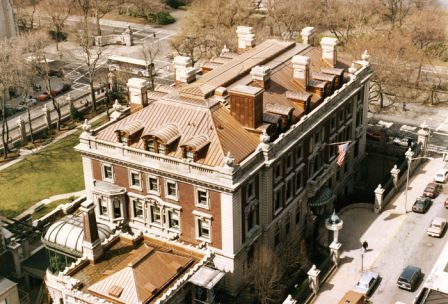Photograph Cooper-Hewitt Museum
Every morning a servant would politely greet him at the doors of the new mansion of Andrew Carnegie. Silently he would make his way to the Aeolian organ in the reception hall where he waited. Then, exactly at 7:00, he began playing. The music wafted upward, gently rousing Mr. and Mrs. Carnegie from their slumber.
Andrew Carnegie's day could now begin.
(On December 28, 1905 The New York Times mentioned, "It is understood that Mr. Gale is very well paid for getting up early enough in the morning to wake Andrew Carnegie.")
For over 30 years, the Carnegies had resided in a brownstone mansion next to the Vanderbilt's lavish Fifth Avenue chateau. Carnegie longed to escape Millionaire's Row where he found the ostentatious behavior of his neighbors distasteful and irresponsible. He felt that the duty of the wealthy was to patronize the arts and to enable those of lesser means to enjoy education and enriched lives.
As the 19th century waned, mansions were cropping up as far north as 70th Street. Carnegie, in a surprising act of real estate leap frog, purchased land 20 blocks further up, across from Central Park, far north of any other mansions--an act some millionaires called foolish. But Andrew Carnegie was not simply seeking isolation, he wanted space. Having grown weary of great residences built shoulder-to-shoulder, he sought open air and, especially, an immense garden--rare in urban environments. When interviewed by The New York Tribune, he said, "The precious little life that has come to us needs the Park and sunshine."
In 1899, he commissioned Babb, Cook & Willard to design his house at 2 East 91 Street. In somewhat incongruous terms, his direction to them was simple: it should be the "most modest, plainest and most roomy house in New York."
Babb, Cook & Willard produced a neo-Georgian English country estate surrounded by a heavy cast iron fence and, without a doubt, the largest lawn and garden in the City. A far cry from the French confections of other millionaires, the dignified brick and limestone residence was completed in 1903. Four stories high, including the attic, its basement descending another three levels. Inside were 64 rooms.
The main entrance, protected by a copper and glass canopy, was approached by a semi-circular drive. The rear facade nearly mirrors the front and sits on a raised terrace with broad steps leading down to the gardens. A separate wing housing the art gallery sprouted at the east side and the glass conservatory sat towards the gardens, connected by a passageway.
 |
| photo Cooper Hewitt Museum |
Carnegie brought in nearly 30 full-grown trees from upstate and Connecticut for his garden. The landscaping was purposely designed so that passersby could pear into and enjoy his gardens.
The first residential structure in New York City to employ a steel framework, the Carnegie house was a wonder of up-to-date technology. A central heating and cooling system brought air in from the outside, filtered it, heated or cooled it and adjusted the humidity. A filtering system purified the drinking water. Two huge boilers provided steam heat to the main house, two smaller ones heated the conservatory, and yet another provided hot water for bathing, dish washing, and such.
In the basement, a miniature railroad transported fuel from the coal bin to the boilers. On a typical winter day two tons of coal would be consumed to heat the mansion. And although Carnegie's drink of choice was Dewar's scotch, the basement included a 1500-bottle wine cellar.
For years the Carnegies lived happily with their 20 servants at 2 East 91st. From his huge desk (so large it had to be constructed inside the office), Andrew Carnegie gave away around $350 million--over $60 million of which went for the establishment and construction of Carnegie Libraries around the country.
 |
| photo Smithsonian Institution Archives |
Andrew Carnegie died on August 11, 1919. Having once said, "no man is a true gentleman who does not inspire the affection and devotion of his servants," he bequeathed considerable amounts to his long-time butler, nurse, the housekeeper and the eldest of his staff. "These four," his will explained, "are as members of my family."
Louise Whitfield Carnegie remained in the house until her death on June 24, 1946. She willed the mansion to The Carnegie Corporation which, in 1972, donated it to the Smithsonian Institution for use as the Cooper Hewitt National Museum of Design. Despite the Smithsonian's astonishing protests that, "We are not persuaded that this house is deserving of landmark status," the Landmarks Preservation Commission deemed it so on February 19, 1974.
The interiors have been essentially preserved, although the beloved organ by which Andrew Carnegie was soothed awake by Walter Gale's morning music is no longer.
Smithsonian Instition Archives
Louise Whitfield Carnegie remained in the house until her death on June 24, 1946. She willed the mansion to The Carnegie Corporation which, in 1972, donated it to the Smithsonian Institution for use as the Cooper Hewitt National Museum of Design. Despite the Smithsonian's astonishing protests that, "We are not persuaded that this house is deserving of landmark status," the Landmarks Preservation Commission deemed it so on February 19, 1974.
The interiors have been essentially preserved, although the beloved organ by which Andrew Carnegie was soothed awake by Walter Gale's morning music is no longer.




.png)
some interiors preserved. 2nd floor is half changed for exhibits. 3rd floor not accessible
ReplyDelete